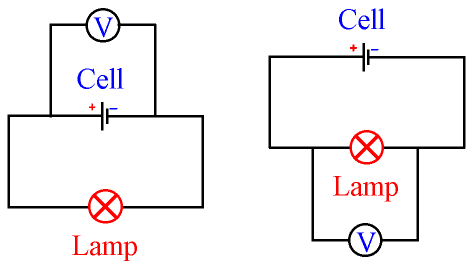Electricity
Volts
Energy is measured in Joules.
The power supply (the cell or battery) gives an amount of energy
to each Coulomb going around an electric circuit.
A 6 Volt cell gives 6 Joules of energy to each Coulomb.
1 Volt = 1 Joule per Coulomb.
The word "per" means "divided by",
so Voltage = Energy ÷ Charge.
This can be rearranged to give
Energy = Voltage x Charge. E = V x Q.
Since Q = I x t, if we write I x t instead of Q in the above equation we get
E = V x I x t. Energy = Voltage x current x time. (see equations).
We can also write Work instead of Energy, so you might see one of the
above equations written as Work = Voltage x Charge. W = V x Q.
Voltage (which is also called potential difference, or p.d.)
is an electrical pressure pushing current around a circuit.
Doubling the voltage will double the current.
Voltage is measured using a voltmeter.
Voltmeter

The voltmeter, shown as a circle with the letter V inside,
is always connected in parallel with the component.
(The voltmeter is said to be connected across the component,
where the word "across" means "in parallel with").
The circuit on the left would show the voltage of the cell.
The circuit on the right shows the voltmeter connected across a lamp.
This will tell you how many Joules of energy are being converted
from electrical energy into light energy (+heat)
for each Coulomb which passes through it.
A reading of 6 Volts tells you that 6 Joules of energy
are being converted for each Coulomb passing through the lamp.
A reading of 10 Volts tells you that 10 Joules of energy
are being converted for each Coulomb passing through the lamp.
